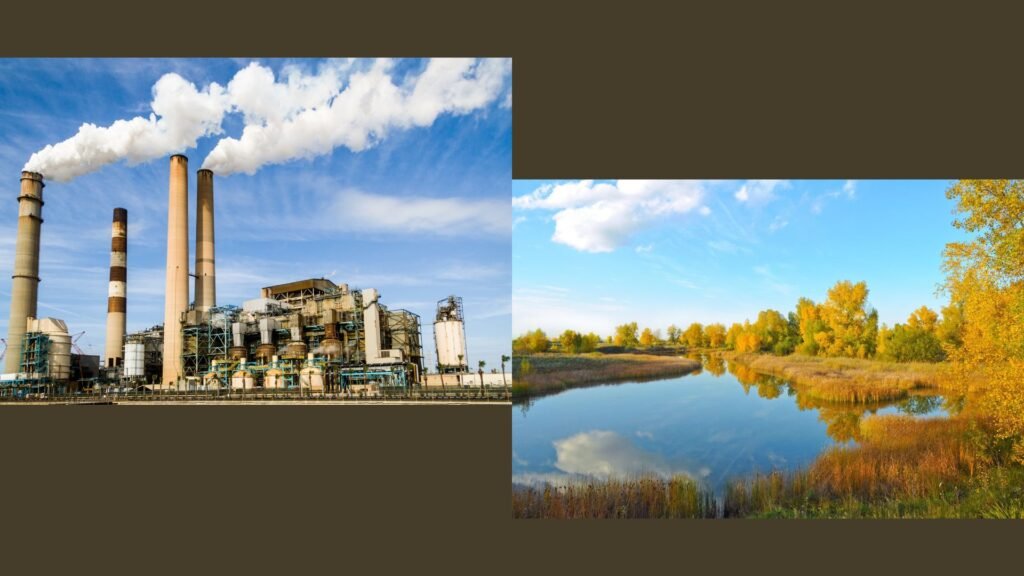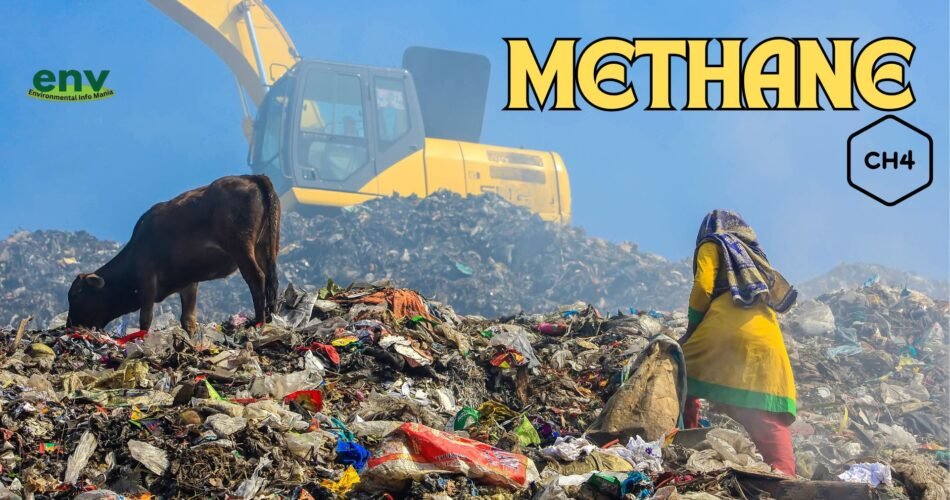This blog contains information about the Uses, Sources and Impacts of Methane This also contains information about the Natural and Anthropogenic Sources of Methane. It also explains the Health and Environmental Impacts of Methane. Also learn about the properties and Mitigation Strategies for Methane emissions in detail.
1. What do you know about Methane?
Methane is a colorless, odorless flammable gas with the chemical formula CH4. This is a Greenhouse gas that is present in the Environment in very small quantities. It is a short-lived Climate Pollutant.
CH4 is a powerful Greenhouse gas that warms the atmosphere even in very small concentrations. It is a strong gas in case of Global Warming because it absorbs 20-25% more heat that Carbon dioxide. Methane is sometimes produced naturally while some of its sources are Anthropogenic in Nature. In addition to its role in Greenhouse effect, it is also a very importance gas in the Atmospheric Chemistry. It produces atmospheric CO (Carbon Monoxide) as an intermediate oxidation product and influences concentrations of hydroxyl radicals and Ozone. Methane is the main part of Natural Gas so it is primarily used as fuel for heat and light, as the starting material of chemical synthesis.
Methane hydrates include frozen methane in the ice-like structure on the ocean floor. The warming of Ocean water can destabilize these frozen particles and they emit large amounts of Methane and accelerates Global Warming. The contributions of methane in Greenhouse Effect and Global Warming cannot be ignored because of its effectivity on the Natural Systems. We can say that Methane itself is a great Environmental Problem. We will learn about the Uses, Natural and Anthropogenic Sources, Environmental and Health Impacts and Control Measures for Methane in detail.
What are the Main Properties of Methane?
Following are some of the important properties of Methane:
- It is a colorless and odorless gas.
- Methane is highly flammable and burns readily in air.
- It is stable but mixture of methane and air can be explosive.
- Methane is lighter than air and is slightly soluble in water.
- It is resistant to chemical agents and it is neutral to litmus.
- Methane has a lifetime of 12 years in the atmosphere.
These are some of the significant properties of Methane.
2. What are the Industrial Uses of Methane in our lives?
The use of methane is in wide range of goods and purposes. We utilize methane for many household and industrial purposes. Following are the Major Uses of Methane in our lives:
i. Fuel:
Methane is widely used as a fuel as it is the starting material for chemical synthesis. It is utilized for generating light and heat for several industrial or domestic purposes. It is a major part of Natural Gas.
ii. Generating Electricity:
Methane is a warming gas and the Electricity need heat for its generation so it is widely used in the Electric Power Plants to facilitate the generation of Electricity. We can use it for energy generation.
iii. Power the Industries:
Industries are powered by some source of energy either Fossil Fuels or any warming gas that helps to create heat. Methane is a very important gas in Powering the Industries on greater level.
iv. Automobile Fuel:
Some of the vehicles that works with the Natural Gas a their fuel, use Methane for fueling. Methane is capable of driving the vehicles on its power and it is a cheaper fuel as compared to Petroleum fuels.
v. Fertilizers:
Fertilizers are the chemicals that facilitates crops and fields to grow properly. Methane is an important ingredient of many of the Important and also effective Fertilizers that are used for crops.
vi. Rocket Fuel:
Rockets are the flying vehicles that helps us to reach the space. The refined liquid form of Methane is the most common and efficient Rocket Fuels that is used for the operation of the Rockets.
These are some of the uses of Methane. Other uses include Cooking food, generating heat etc. As we have seen that we are dependent on methane for many household and also industrial purposes in our lives. But unfortunately it is a powerful warming gas and it contributes in Global Warming and Excessive Greenhouse Effect on the Earth. So, we can say that it is an Extreme Environmental Problem. This blog is all about Uses, Sources, Impacts and Control Measures of Methane.

3. What are the processes involved in Methane Formation?
Methane is formed for the Industrial and commercial purposes in using different processes. These processes are as follows:
Laboratory Methods to produce Methane:
On the laboratory scale, the process used for methane formation is the Decarboxylation of Sodium Acetate. Methane is the simplest form of hydrocarbon containing 1 carbon atom with 4 hydrogen atom. It is prepared by heating the mixture of Sodium Acetate with lime soda in a test tube.
- CH3COONa + NaOH ————> CH4 + Na2CO3
This reaction shows that the heating of Sodium acetate and also lime soda produced methane as the product. This is a common laboratory method to produce Methane. Other methods includes:
- Aluminum Carbide and Water ———-> Methane and Aluminum Hydroxide
- Grignard reagent and Water ———-> Methane etc.
Industrial Methods to produce Methane:
Anaerobic Digestion is the most common method to produce Methane at Industrial Level or Large-scale. Agricultural Residues, Activated Sludge and manure is decomposed by Bacteria in Oxygen-free Environments. This is mostly done in the Bioreactors or any specialized machinery to avoid Oxygen interference. It is an effective way of producing Methane on Industrial Level. Other ways Includes:
- Sabatier Reaction (CO2, H2, Nickel Catalyst ———> Methane and Water)
- Coal Gasification (Coal and Steam at high temperature ———> Gas mixture containing Methane)
- Natural Gas Extraction (Direct Extraction from Natural Reservoirs) etc.
Methane Combustion Reaction:
Combustion of Methane is a chemical reaction that produces CO2 and Water as the result of Combustion reaction in presence of Oxygen. Following Chemical Equation shows the combustion reaction of Methane Gas:
- CH4 + 2O2 ——–> CO2 + 2H2O + energy
The combustion of methane produces CO2 as a byproduct, this is the reason for significance significance of Methane in Global Warming and Climate Change. This blog is all about Uses, Sources, and Impacts of Methane.
4. What are the Natural Sources of Methane?
Methane emits by Natural as well as Anthropogenic Activities in the Environment. Lets have a look on the Natural Sources of Methane.
i. Oceans and Methane Emissions:
There are many tiny organisms and microorganisms that lives on the Ocean Floor. They continuously degrade or destroy Organic Matter. It is the biggest source of methane that emits by the Ocean. In the same way Anerobic bacteria also emits methane during the decomposition process. Ocean Floor also releases bubbles of methane and adds methane to the ocean. When this is more than the Ocean’s Capacity, it is emitted in the open Environment. This is why it is a significant source of Methane.
ii. Methane Emissions and Wetlands:
Wetlands are the water bodies with a diverse species of flora and fauna. These are either wet for most of the time of the year, or throughout the year. Wetlands are the largest source of Methane, contributing as 30% of the Global Methane Production. The Methane emissions from wetlands also depends upon the decomposition of Organic Matter, because wetlands provide a very suitable Environment for the decomposition Activities. The wetlands includes Marshes, Bogs etc. All of them emits methane.
iii. Termites and Methane Emissions:
Termites are the tiny insects that eat wood and also digest it by forming layers of mud-like structures. These termites are expert in digesting wood as they have a strong and immune Digestive system. Termites produces methane during their digestion process to perform complete digestion of wood. They contributes in 11% of the Global Methane Emissions. This shows that these tiny insects are significant contributors of Methane in the Environment.
iv. Methane Emissions and Livestock:
Livestock includes that animals that are specially raised in the farms in order to use them for the welfare of Humans. They eat plants and grasses most of the time. They emit a lot of methane as a digestive gas. Their wastes such as feces, are also a significant source of Methane. India is the biggest contributor of Methane because they do not kill old cows because they consider them Holy. The older a livestock animal will be, the more it will emit Methane into the Atmosphere.
v. Permafrost and Methane Emissions:
Permafrost is any surface area that stays frozen for about 2 years and contain soil, rocks, sand etc. This land freezes the organic matter or biomass present on it. The hydration of Methane traps Methane and CO2 molecules in the frozen layer of ice. It is a significant contributor of Global Warming, because in warm condition the permafrost melts and release a great amount of Carbon dioxide and Methane in the Environment. It also contributes in temperature increase.
These are some of the Natural Sources of Methane. Other sources includes Wildfires, Volcanoes, Wildlife etc. It is a severe Environmental Problem. This blog is all about the Uses, Sources, Impacts and Control Measures for Methane.
5. What are the Anthropogenic Sources of Methane?
Anthropogenic Activities contributes in Methane production in a huge concentration. The Anthropogenic Emissions of Methane are responsible for Global Warming and also enhanced Greenhouse Effect. The lifetime of Methane in the atmosphere is 12 years. Following are Anthropogenic Sources of Methane:
1) Landfills and Methane:
Landfills are the sites where the garbage and trash is collected. These are the special locations that consists of all types of wastes. The landfills are the biggest anthropogenic source of Methane Emissions. When the garbage or wastes are at the same location for a long time, the biodegradation process starts. This emits a huge concentration of Methane. Almost 20% of the methane emissions are from the landfills and also wastes that we as humans produce in large quantities. Poor Waste management is also a great source of Methane formation in the Environment.
2) Fossil Fuel Burning and Methane:
Fossil fuels are remains of dead bodies of plants and animals that are present under the Earth’s crust. We utilize these fossil fuels for generating heat energy by burning them on Industrial Level and for manufacturing purposes. Fossil Fuel burning contains dead organic matter. When they burn they emit a huge amounts of Greenhouse gases including methane into the atmosphere. The emissions from the factories and industries are also Anthropogenic Sources of Methane.
3) Agricultural Emissions and Methane:
Agricultural emissions include the emissions that produces by the use of Synthetic Fertilizers and also Pesticides, by the process of evaporation. The rise in population levels with passing time, are increasing the need of Intensive Farming at great extents. As methane is a part of many fertilizers, so the Agricultural emissions includes Methane emissions. These emissions contributes as 40% of the Anthropogenic Methane emissions because of excessive use of fertilizers.
4) Dams and Methane:
Dams are the Artificial Water reservoirs that facilitates us to collect Rainwater and helps in Rainwater Harvesting at great levels. These dams provide space for collected water for a long time, so many biological activities may starts in Dams. These biological activities include Algae formation, Biodegradation of Organic Matter and also Bacterial Actions. All of these biological activities makes dam a significant source of Methane emissions.
These are some of the important Anthropogenic Sources of Methane. This blog is all about Uses, Sources Impacts and Control Measures of Methane.
6. What are the Environmental Impacts of Methane production?
Methane facilitates us with many Economical sectors and Household Activities, but in the case of Environment it is harmful for the Earth’s Systems and acts negatively for the Environment. We will discuss all the Environmental Impacts of Methane as follows:
I. Climate Change and Methane:
Climate Change is the Long-term shifts of Temperature and also Weather Patterns on the Earth. It is a great Environmental problem as it is going forwards towards extreme impacts. Methane is the Second-Largest contributor of Climate Change. The reduction in Methane emissions can quickly and effectively slow down the process of Climate Change. It is 25 times more powerful than Carbon dioxide in heat-trapping. This is the reason it contributes in elevating the temperature and warming in the Environment.
II. Methane and Global Warming:
Global Warming is the Natural Phenomena of increasing the Earth’s average temperature by Natural and also Anthropogenic Activities. It is a serious Environmental problem of our time. Methane is one of the significant contributor of Global warming. The most important substances that involves in Global Warming are Greenhouse gases. They trap heat and increase the temperature of the Earth. Methane is one of those powerful Greenhouse gases that plays a great role in Global Warming.
Methane vs Carbon dioxide Global Warming Potential:
When we see Methane as a Greenhouse gas, Methane is 28 times more potent than Carbon dioxide in the trapping of heat from the atmosphere. CO2 contributes in most of the Global Warming because of its high concentration in the Environment. While Methane traps much more heat than CO2 in the atmosphere but its concentration is less than CO2, so its contribution in less as compared to Carbon dioxide.
III. Air Pollution and Methane emissions:
Air pollution can be defined as the addition of any foreign substance in the air that cause deterioration of the Air Quality and also Composition of the air. All the greenhouse gases are leading cause of Air Pollution and so Methane is a prominent gas among them. With adding methane concentrations to the Environment, methane is also responsible for the production of ground-level Ozone that is a Major Air Pollutant for the atmosphere. In this way, it produces Methane as well as Ozone and cause Air Pollution.
These are some of the major Environmental Impacts of Methane production. It is one of the Major Environmental Problem and Hazard for the present time. This blog is all about Uses, Sources and Impacts of Methane.
7. What are the Health Impacts of Methane?
With the Extreme Environmental Impacts of Methane, it also lead to many harmful health impacts on the Humans and other forms of Biodiversity. Following are the health impacts of Methane on Humans and Biodiversity:
1: Cardiovascular Diseases:
Cardiovascular diseases includes the diseases related to heart and also its functioning. Methane can be a significant source of Cardiac problems in humans and animals. The main reason behind it is the additional formation of Ground level Ozone that interrupts the normal functioning of Heart directly and also effect heart health. This leads to premature mortality because of cardiac health conditions.
2: Cancer:
Methane can cause the production of VOCs or Volatile Organic Compounds, that can be a direct reason for causing cancer in humans and Biodiversity. It can also react with your body cells of the people and cause cancer. It mostly cause bowel cancer and 70% of the bowel cancer is caused by Methane emissions. This is a great cause of Methane Production.
3: Extreme Symptoms:
The exposure to Methane can cause many extreme health impacts immediately after the exposure. These symptoms may be shortness of breathe, increased heart rate, clumsiness, dizziness, decreased vision, and more. The symptoms shows that Methane is extremely dangerous for health of living organisms and we should also be aware of the control measures of Methane.
4: Respiratory Disorders:
As methane is a Major Air Pollutant, it can cause triggering of Respiratory problems and also many disorders. These respiratory disorders include Asthma, Tuberculosis, Pneumonia, Bronchitis etc. The patients of Asthma and any other dangerous respiratory disorder can face extreme health impacts and also triggers when exposed to methane. These are the main reason behind Respiratory disorder.
These are some of the Health Impacts of Methane in the Environment. This blog is all about Uses, Sources, and Impacts of Methane.

8. What are some Methane Mitigation Strategies?
Mitigation Strategies can help us to reduce Methane emissions at great level.
Methane from Landfills Solutions:
Landfills are the most significant Anthropogenic source of Methane emission or formation. It is very important to find out landfill solutions for reducing Methane emissions. The solutions includes Proper Waste Management, 4R Strategy, Circular Economy, Landfill Methane capture and also other ways to reduce wastes to reduce the Landfill emissions.
Renewable Energy Adoption:
Renewable Energy helps us to minimize the GHG emissions and is an Eco-friendly alternative of the Conventional Energy production processes. The renewable energy sources includes Hydropower, Biomass, Wind Energy, Ocean Energy etc. The Renewable Energy Transition has resulted in the visible decline in GHG emissions including Methane.
Methane Capture Technology:
These are the technologies that helps in capturing Methane from the Environment. Following are some of the Methane Capture Technologies:
Landfill Methane Capture:
It includes capture of methane from the landfills using Pipes and then utilize it in the Power Generation.
Water Manure Capture:
This technique uses the gravity-driven degassing unit with a low vacuum to capture methane from water.
Reservoir Methane Capture:
The water reservoirs such as Dams, Wetlands etc. also emit methane and we can capture through this process.
Other processes of Methane Capture includes Clay-based Methane Capture and Catalyst-based Methane Capture. These technologies can help us to reduce GHG emissions and displace the need of Fossil Fuel Burning.
Avoid Deforestation:
The forests are natural sinks of Greenhouse Gases GHGs including Methane. If we will control the process of Deforestation for human welfare, we can significantly reduce the Methane concentration into the Air and it will also eventually reduce the Air Pollution and Climate Change. Following techniques can help in the reduction of Methane emissions:
Afforestation:
Afforestation is the planting of trees on the locations which were not a forest in the past. This helps in increasing tree cover and cooling the Environment and reducing Methane Emissions.
Reforestation:
Reforestation is the process of restoring the old forested area with new plantation and tree cover. This will help us to get rid of excessive concentration of GHGs into the Environment and give cleansing effect to it removing pollutants like Methane.
By applying these techniques we reduce the Methane Pollution or Emissions at a high rate.
Sustainable Agriculture:
Sustainable Agriculture is the best solution to avoid Agricultural emissions. It involves the use of organic fertilizers and pesticides to avoid synthetic chemicals that harms Biodiversity and use minimum resources for agriculture and farming practices. Sustainable Agriculture Practices also include Efficient irrigation, Vertical Farming, Crop Rotation, Composting and many such Eco-friendly practices that cause less Environmental damage and protect the soil from Nutrient loss and excessive Agricultural Emissions i.e. Methane Emissions. It is opposite of Intensive Farming.
Policy for Methane Emissions:
Policies and Regulations play a very important role in the control or reduction in Environment issues such as Anthropogenic Methane Emissions. The existing policies are considered effective against the excessive methane emissions worldwide. We need more improved Policies and also Agreements for the effective implementation of Mitigating Methane emissions in the world. Following are the Examples of some Policies for Methane Emissions:
- Global Methane Pledge; Launched in COP26 in 2021, aims to reduce methane emissions by 30% from year 2020 to 2030 globally.
- National Methane Action Plans; This is country-based Methane reduction plan that aims to highlight existing policies and future activities to reduce methane. etc.
Despite of effective National and International Policies on Methane emissions reduction, there are still policy and progress gaps between nations in reducing Methane Emissions. So, the effectiveness of Methane Reduction Globally, is still unclear. This blog is all about Uses, Sources, and Impacts of Methane.
To learn about more topics, Click the links below:


Comments